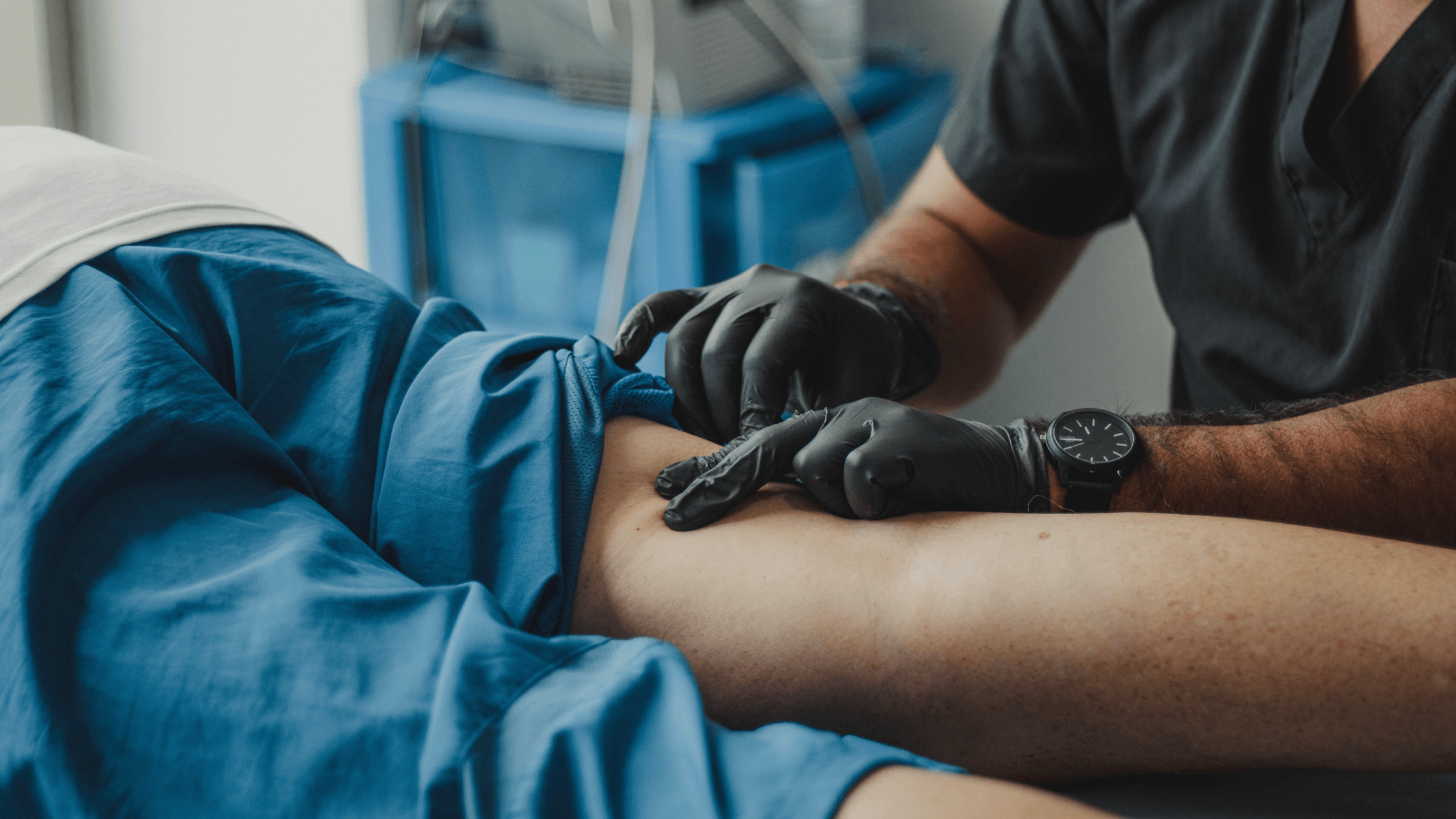Total Knee Replacement Surgery: Preparing, the Procedure, Recovery, and Physical Therapy

Licensed Physical Therapist, PT, DPT // EW Motion Therapy Meadowbrook/280
Total knee replacement surgery, also known as total knee arthroplasty, is a standard procedure to relieve pain and restore function in individuals with severely damaged knee joints. If you or a loved one is considering this surgery, it's essential to understand the process, prepare adequately, and know what to expect during recovery. We have many pre- and post-op patients at EW Motion Therapy, and we do our best to educate them on expectations and prepare their bodies to handle the stress of the procedure. Even if you decide that our services don’t fit your needs, you can still read on to explore how to prepare for the procedure, what the surgery entails, the typical recovery timeline, and the crucial role of physical therapy in the rehabilitation process.
Preparing for total knee replacement surgery
Preparing for total knee replacement surgery involves a few essential steps to ensure a smooth experience and optimize outcomes. Your orthopedic surgeon will guide you through the process, including any conservative treatment options you can try before surgery. Here are some general guidelines to follow:
- Medical evaluation: Your surgeon will perform a comprehensive medical evaluation, including a physical examination, blood tests, and imaging scans (such as X-rays or MRI), to assess the extent of knee damage and overall health.
- Medication review: Inform your surgeon about all your medications, including prescriptions, over-the-counter drugs, and supplements. Some medicines may need to be adjusted or temporarily stopped before the surgery.
- Lifestyle adjustments: Making certain lifestyle adjustments before the surgery is beneficial. Maintaining a healthy weight, not smoking, and exercising regularly within your physical limits can help improve surgical outcomes.
Physical therapy is crucial in preparing individuals for total knee replacement surgery. Here's how physical therapy can help in the preoperative phase:
- Strengthening muscles: Physical therapists can design specific exercises to strengthen the muscles surrounding the knee joint. Stronger muscles provide better support and stability, which can aid in the recovery process after surgery.
- Range of motion exercises: Preoperative physical therapy includes exercises to improve the range of motion in the affected knee joint. This helps increase flexibility, making it easier for patients to perform post-surgery activities and achieve better outcomes.
- Pain management: Physical therapists can teach pain management techniques, such as heat or cold therapy, gentle stretching, or transcutaneous electrical nerve stimulation (TENS). These techniques can help alleviate pain and discomfort before surgery, allowing individuals to manage their symptoms better.
- Education: Physical therapists provide valuable education and guidance regarding post-surgery expectations, mobility aids, and exercises. They can answer questions, address concerns, and ensure patients understand what to expect during recovery.
- Assistive device training: Physical therapists can teach individuals how to use assistive devices, such as crutches or walkers, before surgery. This training ensures that patients are comfortable and proficient in using these devices, which will be necessary immediately after the surgery.
- Functional improvement: Preoperative physical therapy focuses on enhancing functional abilities. This may include practicing activities of daily living, such as getting in and out of bed, sitting down, or climbing stairs. By improving functional skills, individuals are better prepared to manage daily activities during recovery.
- Psychological preparation: Physical therapists play a supportive role in helping patients prepare mentally and emotionally for surgery. They can address anxiety, provide reassurance, and offer coping strategies for fears or concerns.
It's important to note that the specific preoperative physical therapy plan may vary based on individual needs and the orthopedic surgeon’s recommendation. Working closely with a physical therapist, patients can optimize their physical condition and mental readiness for the upcoming total knee replacement surgery, leading to better post-op outcomes.
The procedure: what to expect
Total knee replacement surgery typically takes a few hours and follows a structured process:
- Anesthesia: You will be given either general anesthesia (puts you to sleep) or regional anesthesia (numbs the lower body). The choice depends on your surgeon's recommendation and your medical condition.
- Incision: The surgeon will make an incision over the knee, exposing the affected joint.
- Reshaping the bones: Damaged bone and cartilage are carefully removed from the thigh bone (femur), shinbone (tibia), and kneecap (patella).
- Implant placement: Artificial joint components made of metal and plastic are securely attached to the prepared bone surfaces. These components serve as the new knee joint.
- Closing the incision: The surgeon closes the incision with stitches or staples, followed by applying a sterile dressing.
Recovery timeline
After total knee replacement surgery, a dedicated recovery process is crucial for optimal results. Here is a typical timeline for the recovery process:
- Hospital stay: Most patients stay there only 24-48 hours, but depending on the timing of the procedure and their health after, their hospital stay could be for 2-4 days after the surgery. Pain management, wound care, and early mobilization will be the primary focus.
- Early post-surgery: Physical therapy begins soon after the surgery, with simple exercises to improve blood circulation, prevent stiffness, and regain knee movement.
- Weeks 1-2: Physical therapy intensifies, focusing on increasing knee flexibility, strengthening the surrounding muscles, and improving walking with the help of crutches or a walker.
- Weeks 3-6: As pain and swelling subside, you will gradually reduce the use of assistive devices and focus on regaining independence in daily activities. Physical therapy continues to enhance strength, balance, and range of motion.
- Months 3-6: By this stage, most individuals can walk without assistance. Physical therapy aims to improve endurance, stability, and coordination, enabling a return to more strenuous activities.
Physical therapy is crucial to the recovery process following total knee replacement surgery. Here are some ways physical therapy can assist in the rehabilitation process:
- Pain management: Physical therapists employ various techniques to help manage postoperative pain. These may include manual therapy, modalities like ice or heat therapy, transcutaneous electrical nerve stimulation (TENS), or ultrasound. They can also guide pain medication and teach pain-relieving exercises.
- Range of motion exercises: Physical therapy focuses on improving and maintaining the range of motion in the new knee joint. Therapists prescribe specific exercises to gently stretch and flex the knee joint, preventing stiffness and promoting flexibility.
- Strengthening exercises: Physical therapists design strengthening exercises to target the muscles surrounding the knee joint. Strengthening these muscles is vital for regaining stability, supporting the new joint, and preventing future injuries. Therapists may implement resistance bands, weight machines, or bodyweight exercises to help you increase strength.
- Walking and gait training: Physical therapy includes gait training to help individuals regain a regular walking pattern. Therapists may initially use assistive devices like crutches or walkers and then progress to walking without assistance. They focus on improving balance, coordination, and proper weight distribution during walking.
- Balance exercises: Total knee replacement can temporarily affect balance and proprioception (awareness of body position). Physical therapists incorporate activities to improve balance, stability, and proprioceptive awareness, which reduces the risk of falls and enhances overall mobility.
- Functional training: Physical therapy aims to restore functional abilities, allowing individuals to perform daily activities efficiently. Therapists guide patients in practicing practical tasks such as getting up from a chair, climbing stairs, or bending to pick up objects. This functional training promotes independence and confidence.
- Gradual return to activities: Physical therapists can help you gradually return to activities through exercises tailored to your goals. They may recommend low-impact exercises like swimming or cycling to improve cardiovascular fitness and muscle endurance without putting excessive stress on the new knee joint.
- Education and self-management: Physical therapists educate patients about proper body mechanics, joint protection techniques, and strategies to manage potential challenges during daily activities. They empower patients to actively participate in their recovery and provide advice on home exercises and self-care practices.
Physical therapy sessions are typically scheduled multiple times a week in the initial stages of recovery, gradually tapering as the patient progresses. The duration and intensity of the therapy program depend on individual progress and goals. Working closely with a physical therapist can help you optimize recovery, regain mobility, and achieve long-term functional improvements following total knee replacement surgery.
Do I have to get surgery?
Total knee replacement surgery can be life-changing for individuals with severe knee pain and limited mobility. However, it is also a significant procedure with some risks. Your doctor will likely advise you to try conservative treatment options like physical therapy first before deciding to undergo a total joint replacement.
With the right care team supporting you along the way, you can confidently approach the surgery and work toward successful rehabilitation by understanding the preparation process, the surgical procedure, the recovery timeline, and the importance of physical therapy. Remember, each person's journey is unique, so follow your surgeon's instructions and collaborate closely with your physical therapist to achieve the best possible outcome. We consistently communicate with our patients’ primary care providers at EW Motion Therapy to ensure the highest standard of care across the board. If you are curious about what else physical therapy can do for you, click the button below to download our answers to 20 frequently-asked physical therapy questions.


